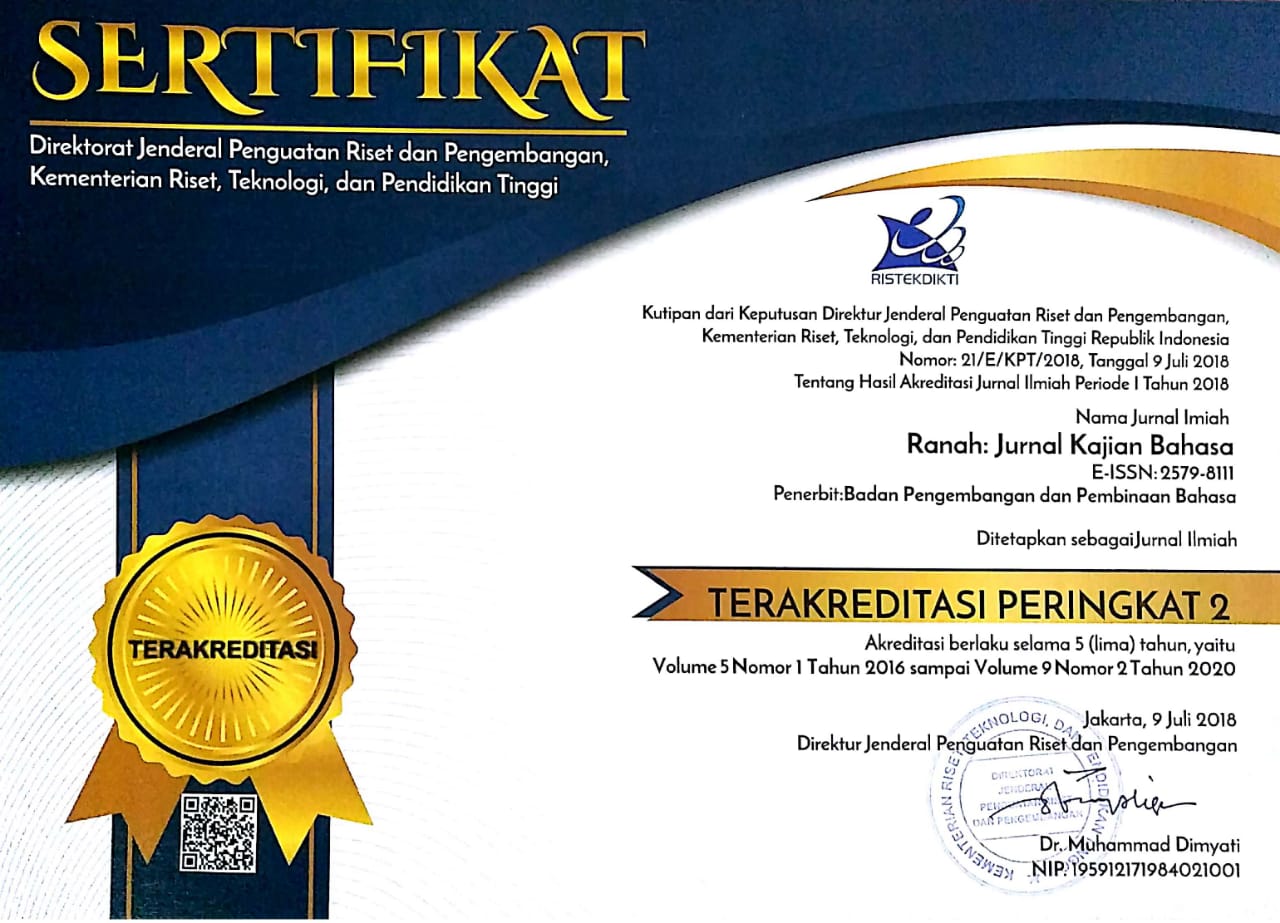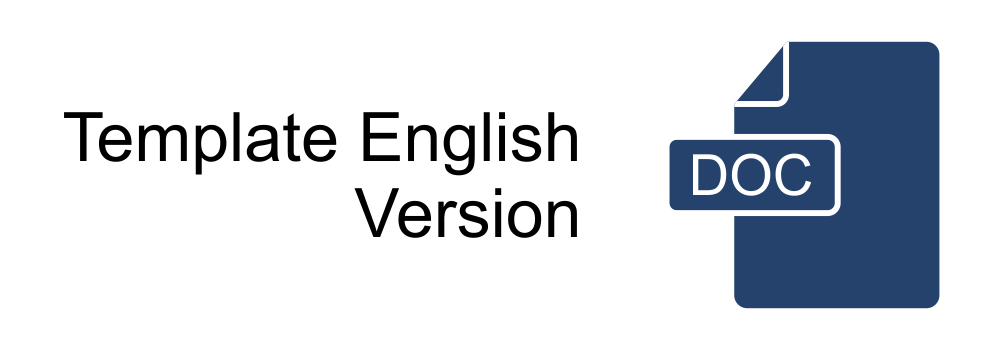Fillers and Their Functions in Emma Watson’s Speech
Abstract
Fillers are utterances or phrases that are used in speaking to fill in the moment of silence to connect thoughts or ideas. This paper investigated the types and functions of fillers used by Emma Watson in her speeches. The researchers formulated two questions to be resolved. First, what are the types of fillers used in Emma Watson’s speeches? Second, what are the functions of filler words in the speeches? Data, consisting of 93 occurrences of fillers, were collected from Emma Watson’s speech scripts in three videos. To solve the research questions, the researchers used the descriptive qualitative approach and discourse analysis. Results showed that Watson used two types of fillers, namely unlexicalized filled pauses (71 occurrences) and lexical filled pauses (22 occurrences) and five functions of fillers, namely hesitating, empathizing, mitigating, editing term and time-creating devices.
Abstrak
Filler atau kata pengisi merupakan ujaran atau frase yang digunakan dalam jeda percakapan untuk menghubungkan gagasan atau ide berikutnya. Makalah ini menyelidiki jenis dan fungsi kata pengisi yang digunakan oleh Emma Watson dalam pidatonya. Para peneliti merumuskan dua permasalahan. Pertama, apa jenis kata pengisi yang digunakan dalam pidato Emma Watson? Kedua, apa fungsi dari kata pengisi dalam pidato Emma Watson? Data, yang terdiri atas 93 kata pengisi, dikumpulkan dari tiga naskah video pidato Emma Watson. Untuk menjawab kedua permasalahan dalam studi ini, para peneliti menggunakan pendekatan kualitatif deskriptif dan analisis wacana. Hasil analisis menunjukkan bahwa Watson menggunakan dua jenis kata pengisi, yaitu jeda terisi non-leksikal (71 kali) dan jeda terisi leksikal (22 kali), serta lima fungsi kata pengisi, yaitu sebagai perangkat keragu-raguan, berempati, mengurangi efek, memperbaiki istilah, dan menambah waktu.
Keywords
Full Text:
PDFReferences
Baalen, I. V. (2001). Male and Female Language: Growing Together? Retrieved from http://www.let.leidenuniv.nl/hsl_shl/van%20Baalen.htm
Basurto Santos, N. M., Hernández Alarcón, M. M. & Mora Pablo, I. (2016). Fillers and The Development of Oral Strategic Competence in Foreign Language Learning. Porta Linguarum, 25(1), 191-201. https://doi.org/10.30827/Digibug.53916
Biber, D. Leech, G. &Conrad, S. (2004). Longman Student Grammar of Spoken and Written English. London: Pearson Longman.
Bogdan, R. C., & Biklen, S. K. (1982). Qualitative Research for Education: an Introduction to Theory and Methods. Boston: Allyn and Bacon.
Brown, G & Yule, G. (1983). Discourse Analysis. Cambridge: Cambridge University Press. https://doi.org/10.1017/CBO9780511805226
Carter, R., Goddard, A., Reah, D., Sanger, K. & Bowring, M. (1997). Working with Texts: A Core Book for Language Analysis. London: Routledge. https://doi.org/10.4324/9780203468470
Clark, H. H. & Clark, V. (1977). Psychology and Language: An Introduction to Sociolinguistics. New York: Harcourt Brace Javanovich Inc.
Clark, H. H., & Fox Tree, J. E. (2002). Using uh and um in Spontaneous Speaking. Cognition, 84(1), 73-111. https://doi.org/10.1016/S0010-0277(02)00017-3
Corley, M., & Hartsuiker, R. J. (2011). Why um Helps Auditory Word Recognition: The Temporal Delay Hypothesis. PLOSONE, 6(5). https://doi.org/10.1371/journal.pone.0019792
Dlugan, A. (2011). How to Stop Saying um, uh, and other Filler Words. Retrieved from http://sixminutes.dlugan.com/stop-um-uh-filler-words/
Erten, S. (2014). Teaching Fillers and Students' Filler Usage: A Study Conducted at ESOGU Preparation School. International Journal of Teaching and Education, 2(3), 67-79.
Foss, D. J & Hakes, D. T. (1978). Psycholinguistics: An Introduction to The Psychology of Language. Englewood Cliffs, NJ: Prentice-Hall.
Hasling, J. (2006). The Sudience, The Message, The Speaker (7th ed.). Boston: Mc Graw-Hill.
Hutchins, R. (2011). How to Stop Saying um, uh, and other Filler Words. Retrieved from http://sixminutes.dlugan.com/stop-um-uh-filler-words/
Irvine, C. A., Eigsti, I. M., & Fein, D. A. (2016). Uh, um, and autism: Filler Disfluencies as Pragmatic Markers in Adolescents with Optimal Outcomes from Autism Spectrum Disorder. Journal of Autism and Developmental Disorders, 46(3), 1061-1070. https://doi.org/10.1007/s10803-015-2651-y
Jordan, D. J. (2001). Leadership in Leisure Service: Making a Difference (2nd ed.). State College, PA: Venture Publishing, Inc.
Kharismawan, P. Y. (2017). The Types and The Functions of The Fillers Used in Barack Obama's Speeches. International Journal of Humanity Studies (IJHS), 1(1), 111-119. https://doi.org/10.24071/ijhs.2017.010112
Kowal, S., Bassett, M.R. & O'Connell, D.C. (1985). The Spontaneity of Media Interviews, Journal of Psycholinguistic Research, 14, 1-18. https://doi.org/10.1007/BF01067471
Lease, M., & Johnson, M. (2006). Early Deletion of Fillers in Processing Conversational Speech. Proceedings of the Human Language Technology Conference of the North American Chapter of the ACL, pp. 73-76. https://doi.org/10.3115/1614049.1614068
Long, Y. H.& Ye, H. (2015). Filled Pause Refinement Based on The Pronunciation Probability for Lecture Speech. PLoS One. 10(4). https://doi.org/10.1371/journal.pone.0123466
Maclay, H.& Osgood, C.E. (1959). Hesitation Phenomena in Spontaneous English Speech, WORD, 15:1, 19-44. https://doi.org/10.1080/00437956.1959.11659682
Matthei, E.&Roeper, T. (1983). Understanding and Producing Speech. New York: Universe Books.
Nurjamin, L. R., Nurjamin, A., & Melati, R. (2020). What EFL Learners Say in Managing Their Speech During Academic Presentations. In Twelfth Conference on Applied Linguistics (CONAPLIN 2019). (pp. 116-120). Atlantis Press. https://doi.org/10.2991/assehr.k.200406.023
Rieger, C. (2003). Disfluencies and Hesitation Strategies in Oral L2 Tests. Proceedings of DiSS'03. 5-8 September 2003, Göteborg University, Sweden.
Rose, R. L. (1998). The Communicative Value of Filled Pauses in Spontaneous Speech. Unpublished master's thesis, University of Birmingham: Birmingham, UK
Samadian, T., & Birjandi, P. (2015). Iranian EFL Learners' Favored Strategic Fillers for Noticed Gaps Amid Conversations Across Proficiency. Teaching English Language, 9(1), 125-143.
Santos, N. B., Alarcón, M. M. H., & Pablo, I. M. (2016). Fillers and The Development of Oral Strategic Competence in Foreign Language Learning. Porta Linguarum: revista internacional de didáctica de las lenguas extranjeras, (25), 191-201.
Shiffrin, R. & Richard, M. (1978). Short-term Forgetting of Item and Order Information. Journal of Verbal Learning and Verbal Behavior, (17:2), p.189. https://doi.org/10.1016/S0022-5371(78)90146-9
Stark, H.& Trinidad, S. B. (2007). Choose Your Method: A Comparison of Phenomenology, Discourse Analysis, and Grounded Theory, Qual Health Res. 17(10), 1372-1380.
https://doi.org/10.1177/1049732307307031
Stenström, A. (1994). An Introduction to Spoken Interaction. London: Longman.
Swerts, M. (1998). Filled Pauses as Markers of Discourse Structure, Journal of Pragmatics, (30), 485-496. https://doi.org/10.1016/S0378-2166(98)00014-9
Tottie, G. (2011). Uh and um as Sociolinguistic Markers in British English. International Journal of Corpus Linguistics, 16(2), 173-197. https://doi.org/10.1075/ijcl.16.2.02tot
Wood, L. A., & Kroger, R. O. (2000). Doing Discourse Analysis: Methods for Studying Action in Talk and Text. Thousand Oaks, CA: Sage Publications, Inc.
Working, R. (2016). 6 Ways to Stop Saying' uh,'' you know' and Other Word Fillers. Retrieved on January 12, 2019 from https://www.ragan.com/6-ways-to-stop-saying-uh-you-know-and-other-word-fillers/
DOI: https://doi.org/10.26499/rnh.v10i1.1350
Refbacks
- There are currently no refbacks.








